
Crop Scouting Upgraded With A New Farming App
Crop Scouting And Farming Apps
Farmers around the world have to rely on the process called crop scouting to make sure their crops stay healthy throughout the growing season. Traditionally, hired experts, known as “scouts”, have had to walk the fields in search of problem areas, take samples, and fill in reports. In recent years, farming apps have made this procedure easier and much more accurate. They are digital online platforms using GPS and integrating big data collected by drones, satellites, weather information services, to name a few. There are many scouting apps available today, usually with additional useful features, like historical weather, notifications, and zoning. Anyone in the agribusiness, interested in the effective monitoring of fields, can benefit by creating an account in a scout app and conducting crop scouting on an entirely new level of efficiency.
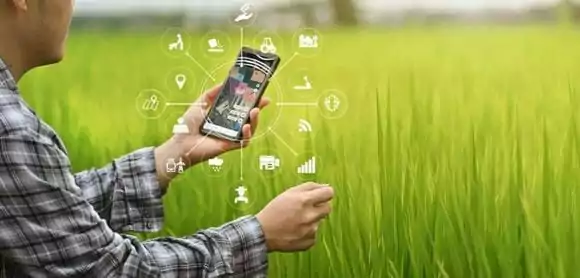
Farming And Crop Scouting
In a long growing season on a farm, many things can go wrong in the field. Pests, diseases, uninvited weeds, weather risks, you name it. On a small scale, they may go unnoticed, but over time result in considerably lower yields and loss of revenue. To prevent this from happening, a farmer has to check the state of their crops at least on a weekly basis. Crop scouting has traditionally been performed by agriculture experts to gather information about any health issues of the growing crops.
Classic Crop Scouting
Scouts have always had to rely on a set of basic skills:
- Walking in specific patterns
- Observing crops closely to discover damage from pests or diseases
- Taking notes
- Taking samples
- Filling reports
The traditional scout’s equipment may include an impressive number of items:
- A clipboard
- A pencil
- A pocket knife (or scissors)
- A magnifying glass (hand lens)
- A pair of safety glasses
- A bag for samples
- A digital camera
- A standard report form
- A field map
- Provisions (food, water)
- First Aid Kit
The list can go on and on, as the choice of equipment can vary from scout to scout, but the point is, the traditional crop scouting can be a real physical toil. To better understand why, let’s take a closer look.
Scouting Patterns
Let’s start with walking, the most basic skill and activity performed in crop scouting. Clearly, it is impossible to cover the entire field’s area on foot, especially a large field. That would take an enormous amount of time and effort. Besides, depending on the growth stage, some crops can stand tall and very close together, preventing access. The only way to walk through would be by cutting the plants, which is, understandably, the worst plan imaginable, since it causes damage to the field. Yet the accuracy of crop scouting is directly proportional to the amount of covered ground, and a scout has to deal with it somehow.
Over the years, various walking patterns have been invented as a way of solving all of these problems. For example, a somewhat outdated scout’s manual in Wisconsin recommends an M-shaped route in a rectangular or square field as the most efficient one. Obviously, the main idea behind it is moving in zig-zags across the field to maintain balance between accuracy, covered area, and time spent on a single field.
The Iowa State University, on the other hand, suggests, as a slightly more varied and straightforward approach, three distinctly different scouting patterns:
- Transect, basically a straight diagonal path through the field;
- Zig-zag, reminiscent of the M-shaped type;
- Diamond, which is exactly what it sounds like: a polygon-shaped round-about route.
Would any of these patterns guarantee a perfect scan of a field? Realistically speaking, probably not, especially if the field is extra large while the time given for crop scouting is preciously little. In our fast-rotating world today, the luxury of time simply no longer exists. Hence, some areas will inevitably be overlooked, leaving farmers with lower yields in the long run.
It is known as the human factor, which is not synonymous with fault. Scouts can do their job extremely well, putting their utmost effort into it, using the best available equipment. They can rely on well-tested and acclaimed techniques, but still be unable to account for every minute issue with the crops of a given field.
Observation And Sampling
Now let us imagine the scouting pattern has been decided on and it’s time to go and observe the crops. How strenuous it would be to scrutinize every crop on the way, looking for tiny imperfections such as leaf damage or abnormal color? Even the most experienced, skillful human eye cannot function with a perfect accuracy hundred percent of the time. The larger the field, the more room for accidental human-factored errors. What is even more disconcerting, is the amount of physical work a scout has to apply to this job. It is tedious, challenging, and probably detrimental to the person’s health.
And then there is physical sampling, cutting leaves (when it is absolutely necessary) with a pocket knife or scissors, adding to the toil. A digital camera, in this case, is arguably the most useful tool for a scout when it comes to taking samples.
A scout app on a mobile device, on the other hand, would allow the expert to take snapshots, using the phone or tablet instead of a digital camera, with one crucial exception. A handheld device allows a scout to instantly upload the images into a database and share this data with the field’s owner.
Paperwork Toil
Finally, the classic crop scouting wouldn’t be complete without taking notes every time an abnormality has been spotted and filling the standard report forms at the end of a scout tour. It ties in with the overall problem of excessive physical labor and time loss. Additionally, paperwork tends to stack up and keeping it organized becomes an extra challenge.
How Effective Is Classical Scouting?
With this information in mind, let’s now muse a little about the possible degree of accuracy achievable by the conventional crop scouting. The physical limitations definitely prevent a perfect scan of the field. Pressed for time, a scout can potentially miss not just a single crop issue but an entire problem area. That would depend on the field’s size and would not be a scout’s fault, of course. Unfortunately, the amount of physical stress put on the scout can further decrease the efficiency of the procedure and be detrimental to that person’s health. Finally, stacks of technical documentation create an extra challenge of storing and sharing the acquired data. In other words, unaided by technology, crop scouting does not guarantee a complete accurate portrait of the state of crops in a given field, resulting in potentially lower yields and, by extension, revenue loss.
EOSDA Crop Monitoring
Fields analytics based on high-resolution satellite images to track all the changes on-the-spot!
Farmer’s Concerns
The essential problems that any farmer encounters while growing crops can be divided into several categories:
- soil issues
- pests and diseases
- nutrition/fertilization decisions.
Soil Moisture
The soil has to be properly irrigated in order for the plants to perform well and grow healthy. Water can be a source of both life and death for the crops, depending on its amount and the individual needs of every crop. Obviously, if a plant does not get enough water it will experience a drought that might kill it. However, over-watering is a problem at the opposite extreme of the spectrum. In both cases, a crop will show troubling symptoms of malnutrition, not to mention the ever-present risk of wasting water resources. Soil moisture mapping performed by satellites and integrated into farming apps could be a cheap solution.
Pests And Diseases
The scourge of every farm, armies of harmful microorganisms and insects regularly plague the crops. There are many kinds of diseases and pest species that can be identified through crop scouting by closely examining the leaves of every plant. Yet imagine the waste of time and the amount of overlooked areas for every field. Modern satellites are capable of detecting these areas at a glance, while some farming apps are equipped with an automatic pest and disease identification system.
Nutrition Via Fertilization
Finally, feeding the crops can be a real challenge for farmers. Similarly to the irrigation problem, the improper fertilizer plan can both underfeed the plants and poison them, depending on the vegetation and soil variations across the field. What is worse, an accumulation of nitrates in the soil leads to its infertility and contributes to the green gas effect, boosting global warming. In other words, a blind misapplication of nitrogen fertilizer is a potential local environment disaster that coincides with yield and revenue loss. You can read more about this global issue here https://www.ncbi.nlm.nih.gov/pmc/articles/PMC5359602/.
Some farming apps use satellite imagery to display the vegetation variations and productivity zones for individual fields, allowing farmers to adjust their fertilizer plan with considerably more precision.
It is clear that classic crop scouting does not adequately meet the farmers concerns. However, modern technology is about to revolutionize farming and crop scouting alike. Solutions to the global climate issues also depend on this change.
Crop Scouting Updated
Fortunately, in our digital age, conventional crop scouting limitations are quickly becoming obsolete. Airborne technology (drones) equipped with digital cameras and compatible with any other computing devices (android, tablet, laptop, personal computer), map fields and scan crops in minutes taking snapshots on the fly. Drones create an almost literal bird’s-eye view of a field, saving scouts time, energy, and costs. They could not by any means replace humans on the ground but offer powerful technological assistance.
Satellite Imagery
The next step-up in this digital revolution of field monitoring is satellite imagery. It has several important advantages over using drones. Satellites are capable of
- automatically mapping vast amounts of the Earth’s surface in an incredibly short time;
- automatically revisiting the same area in a cycle that usually takes only several days, thus regularly updating the maps;
- creating images with high-resolution;
- making maps based on the wavelengths of light beyond the ordinary human range.
We should take that last point and study it in more detail, in order to understand how it can benefit crop scouting.
Remote Sensing
It’s all about light and its interaction with plants. As you know, different wavelengths of light manifest themselves as different colors. Think of it as low and high pitch. Red is the lowest and the longest wave, violet is the highest and the shortest, while yellow and green are somewhat in the middle. That is what we call a visible spectrum.
Human eyes are natural remote sensors, they capture light and see it as the seven colors of a rainbow or the visible spectrum. However, there is more to light than meets the eye! Beyond red is the infrared, and beyond violet is, you guessed it, the ultraviolet. Our eyes are naturally limited to whatever happens in these wonderful invisible realms.
What Does It Have To Do With Plants, Though?
Like most objects in our universe, plants absorb and reflect light. By experience, we all know that green leaves are healthy, while the yellow ones are most likely not. That is because in a healthy plant, that famous pigment, chlorophyll, absorbs every wave of light in the visible spectrum, except green. That’s all we humans are able to see. What you can’t see is that it also reflects light very brightly in the wavelengths longer than red, aka near infrared. Thus, in the most simple terms, no chlorophyll – no green and no infrared.
Enter The Multispectral Remote Sensing!
As its scientific name suggests, it deals with more spectra than one. Here is the game changer: a satellite can photograph crops in the near infrared, thus monitoring their health more effectively than with an unaided eye. Similarly, soil viewed in the near infrared reveals a lot about its composition. To find out more about the exact science behind it, visit https://science.nasa.gov/ems/08_nearinfraredwaves.
Many farming apps today have already integrated different types of remote sensing into their field monitoring methodologies, thus revolutionizing crop scouting.
How Internet And Global Positioning System (GPS) Boost Crop Scouting
Picture a scout alone out in a field taking notes, eager to share freshly collected data on a poor state of crops at a particular location with the employer. Without internet connection, only one option would be feasible, a phone call. However, it is not a reliable means of transferring data, since it is, by nature, closer to hearsay than an official report. We all know the infamous telephone game where a message gets distorted as it travels from a person to person by hearsay. Physically taking all the paperwork and samples to the employer might be the only reliable option. Think about how much time is wasted on the conventional crop scouting this way.
And now let’s add the internet to the equation. Scouting apps rely on it to ensure instant transfer of data from one device to another. Online, data travels with the speed of light and, if properly encrypted, does not get distorted, thus saving time without accuracy loss. In other words, a scout can create a digital report and share it online right on the spot, without any delay whatsoever. This type of communication most closely resembles flashing light across great distances. Around the Earth, light travels literally instantaneously, taking a few seconds at worst.
Suppose a scout also wishes to somehow share the exact location on a field with the employer. Thanks to GPS, it can be done with the help of an interactive online map created by a satellite. Most farming apps usually have a feature enabling a scout to place a point on the map, add a description and a photo, for visual aid, and then save it online. That point with its coordinates will never get lost until you decide to remove it.
No one should be alone and isolated out in the fields or back in the office, relying on traditional means of communication that waste time and energy. The Internet creates an instant worldwide connection, while GPS makes sure no point of interest will get lost on the map.
Crop Scouting With Farming Apps
As you can see, a modern scout can be supported and assisted by a vast array of technological wonders, from a drone, through satellite imagery in the near infrared, to the interactive GPS maps. We are talking about huge amounts of data, often being collected in real time and being constantly updated, that can be shared around the world wide web in seconds. The big question here is how and where to store it, how to bring order out of chaos?
In recent years, this need for user-friendly data consolidation has driven technology to a revolutionary solution.
Farming Apps
Meet farming apps, programs designed to make field monitoring and crop scouting fast, efficient, and easy. They are often referred to as digital platforms because at their core is the idea of machine learning and integration. Farming apps integrate big data from a number of various sources and present it to the users, all in one place. Satellite imagery, weather data, vegetation maps, history of climate of a particular area, basically every potentially collectable and useful bit of data can and will go into the app’s database. Next, it gets converted into an interface that can be easily understood even by the most non-expert users and become a powerful digital data-driven tool.
There already exists a considerable variety of farming apps, with different range of capabilities. For time-saving purposes, we are going to examine only six of the most popular farming apps that are especially suitable for digital crop scouting. Let’s dive right in!
FarmLogs
Among the advantages of this digital platform is that it is available on mobile as well as on desktop (PC). It offers its users a 30-day free trial. As far as scouting goes, a user can manually geotag notes and pictures on the map and keep them in the digital log. This replaces paperwork and physical sample-taking with a single device use, such as a smartphone, a tablet, a laptop, or a desktop computer. Apart from that, FarmLogs app provides users with marketing information, rainfall and heat accumulation history, crop insurance information, and other important features.
Climate Field View
This online platform lets farmers prescribe the seeding scripts and fertilizer amounts online, based on the vegetation maps. FieldView relies heavily on the satellite imagery to provide users with an accurate overall picture of the state of their crops throughout the season. The prescriptions are also based on the historical weather data for the particular field.
ExactFarming
Automated scouting is what this farming app offers to the users helping them to save as much time as possible. It lets farmers manually create scouting tasks. Scouts get notified about a new task automatically. As soon as a scout is done with the check-up of a problem area, he or she sends the report with pictures back to the farmer. Among other useful features offered by ExactFarming are weather data, NDVI (a vegetation index) to analyze the changes in the biomass, and resource management, to name a few.
EOSDA Crop Monitoring
EOSDA launches a brand new scouting app with additional features for effective field monitoring throughout the season. Our application offers digital assistance to farmers, insurers, and traders. It is available in two versions, the scouting application and the extended web edition. The web version is equipped with:
- Managing fields tab;
- Advanced weather analytics;
- Scouting;
- A user-friendly system of alerts and notifications;
- Zoning (based on the vegetation indices);
- Growth stages identification
Every one of these features can be used in order to boost the efficiency of crop scouting. Fields are monitored regularly by satellites, with updates every 3-5 days coinciding with the revisit cycles. A user needs to add a field to the system to start monitoring it. The software also provides you with the insightful historical data on the field’s temperatures and precipitation rate, shows current weather, and allows for making weather predictions.
The web version is to give the user a bird’s eye view of the fields’ boundaries, weather, and the state of their crops. It sends notifications and alerts about weather risks and vegetation index changes, based on the NDVI values. Thanks to the zoning feature, a field on the interactive map can be divided into 2-7 zones with different vegetation levels, from sparse to dense. The synergy of all this data allows you to effectively create scouting tasks, fix issues on a weekly basis, thus ensuring higher yields.
A Scout With A Handheld Device
The mobile version of EOSDA Crop Monitoring is designed to facilitate the crop scouting procedure. Here’s how:
Imagine the following scenario: the owner of a given field has been notified of an abnormal change in the NDVI value (some of the vegetation might be experiencing problems). He or she then opens a vegetation zoning map and finds suspicious problem areas, tags them and creates as many scouting tasks as is necessary. A scout with a smartphone or tablet gets notified about it, opens the app and sees the exact location that requires attention. Next, arriving at the spot, the scout conducts the full check-up for weeds, pests, or diseases. Now it is sampling time! There is no need to cut or tear the leaves, though, because most handheld devices today are equipped with a camera. All the scout has to do is to take as many snapshots as needed for samples and upload them into the special section of the task in the application. Right on the spot, the scout can then fill in all of the data collected into a report form. The person who has set the task will be able to export this report as an excel spreadsheet in the matter of seconds. This, in a nutshell, is the scouting procedure assisted and made easy with an application available on a handheld device.
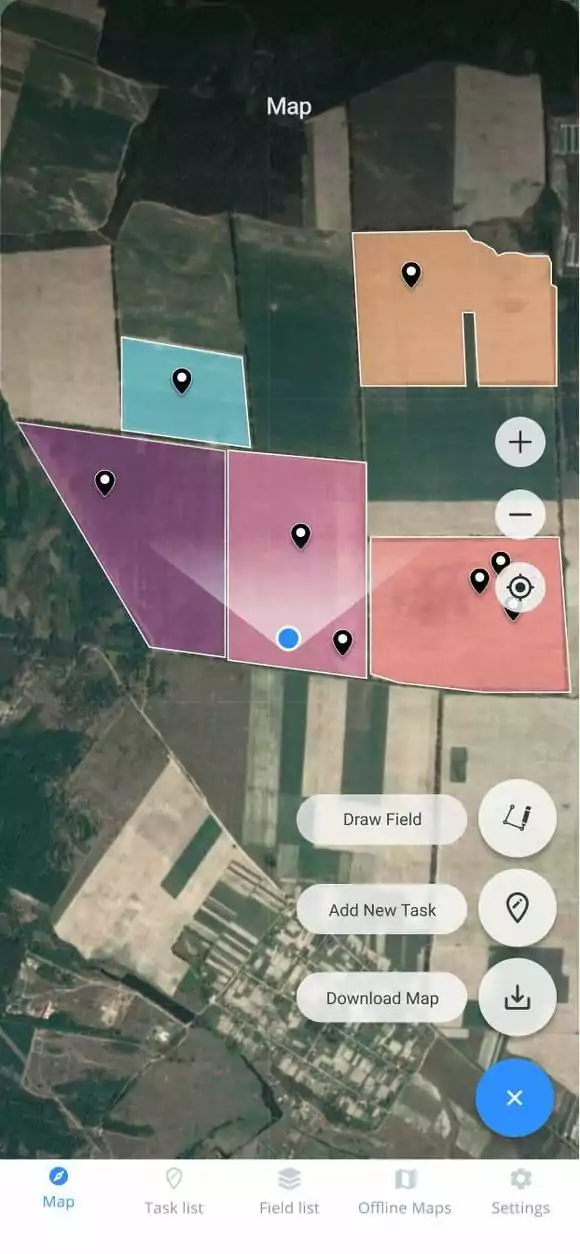
EOSDA Crop Monitoring In Action
Now it’s time to see how the integration of various types of data really aids crop scouting. Here we have real cases of fields with problem areas that require attention. A scout would have been sent to check them out and make a report.
Two things that we should focus on are:
- How do we find out about problem areas?
- How do farming apps make scouts’ lives easier, while also saving time and expenses.
Data Integration In One Screen
This case perfectly illustrates the practical significance of the remote sensing as integrated on EOSDA Crop Monitoring. The field has been scanned by a satellite in the near infrared to reveal the state of its vegetation. As you can see, we have some variations in the growing crops.
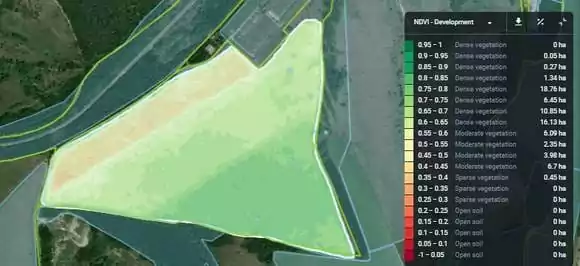
This image of a field is based on the Normalized Difference Vegetation Index (NDVI), as measured by a satellite remote sensor. It is a product of the observation of crops from space in the near infrared, revealing more details about the vegetation growth. EOSDA Crop Monitoring converts the raw data into a scale of color hues, from red to green, with the appropriate values spanning from -1 to 1. In the legend to the right, every point on the scale is characterized and described for convenience. For example, -1 to 0.25 is “open soil,” while 0.6 to 1 is “dense vegetation.” Despite the fact that only four different types of variations are detected, i.e. open soil, sparse, moderate, and dense vegetation, there are enough grades to create a subtle picture. Besides, for each grade a corresponding area of a field has been calculated in hectares, to provide a detailed scope of the state of the crops. For instance, an area with a moderate vegetation with the indices from 0.55 to 0.6 occupies 6.09 hectares of the field.
Creating A Scouting Task
Dropping a point on the map where you want a scout to go and inspect is all there is to it, basically. A user can choose and manually type in the task’s name, assign the scout, and add a description if necessary.
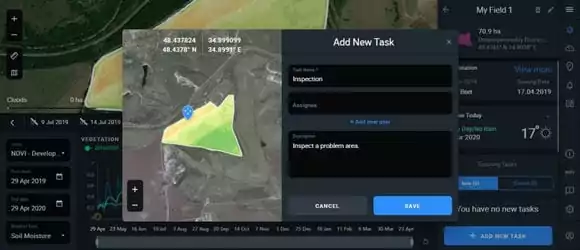
The location of the scouting task is now fixed as a point on the map, and it looks like this:
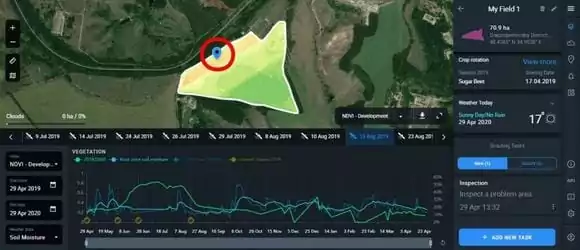
Hovering a mouse over the scouting task point on the map will show a tooltip with the task’s name, description, date of creation, as well the field’s name.
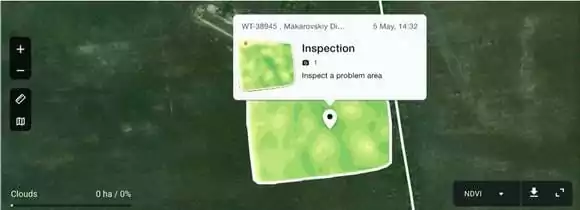
Here, a scouting task is an inspection of a problem area by an insurance company to validate the damage. Thanks to the integration of data in one app and the connectivity, all parties can easily monitor the performance of this task in real time. A farmer, the owner of a field, an insurance company staff, as well as the scout, will see the same picture. The scout, by the way, won’t have to walk the field in various patterns for hours under a scorching sun. Instead, he or she will go straight for the point shown on the map, using GPS integrated into the app on their mobile device.
Productivity Zones
One of the coolest features of EOSDA Crop Monitoring is its zone productivity calculator. As you remember, one of the most essential needs of a farmer is to fertilize the field properly. Fields usually have productivity variations and some farming apps allow for them to be visible like in the image below.
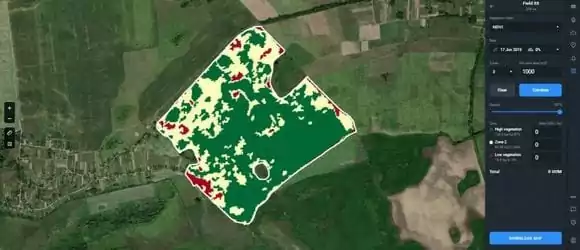
Generally speaking, the green areas require less fertilization, while the red ones should be adequately fed or else they will most definitely starve. Thanks to this feature, farmers can create more precise fertilization plans and plot the route across the field more accurately.
Cold Stress
EOSDA Crop Monitoring detects not only changes in the vegetation growth, as revealed by the NDVI curve on the chart, but also the critical temperature points. In this case, temperatures dropped to a critical minimum and the NDVI curve went down as well. According to the chart below the map, the cold stress event occurred around the 23rd of November. It looks like a red bar perpendicular to the curve.
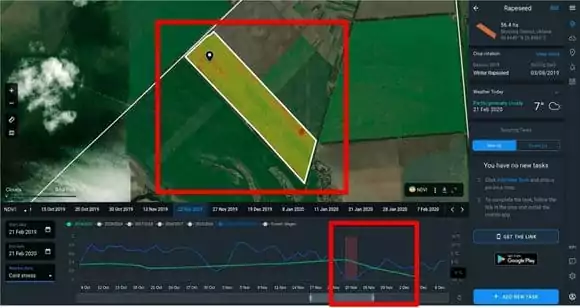
Notice the colors of the vegetation on this image. As you remember, the greens and the yellows signify the dense and moderate vegetation levels. In other words, this field is not in a perfect state but it’s not exactly in a bad one either. This is before the cold stress event.
Now watch what happened to the vegetation after having experienced a cold stress.
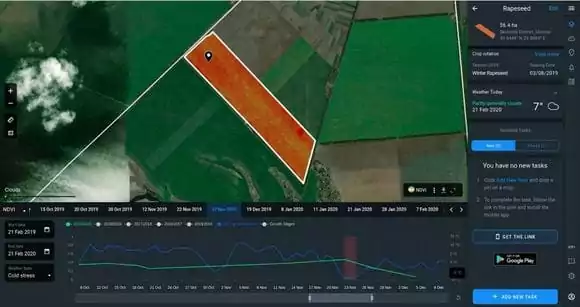
Note, in particular, the change from yellow to heavy orange all across the field. Some red spots have remained about the same, but overall, the vegetation has sustained a lot of damage. Thanks to remote sensing, EOSDA Crop Monitoring highlights these important changes for the users to see.
For an insurance company, these two images, that are only one week apart, serve as an undeniable proof of the damage caused by a naturally occuring cold stress.
Flooding
The owner of the field seen on the interactive map below claims that it has been flooded by excessive rainfall during May. An insurance company wishes to investigate the claim using the EOSDA Crop Monitoring platform. Near infrared satellite imagery has been integrated here to help detect and identify the exact location of areas where the water levels got critical for the vegetation. Every dark-red spot on the map is, effectively, a heavily flooded area.
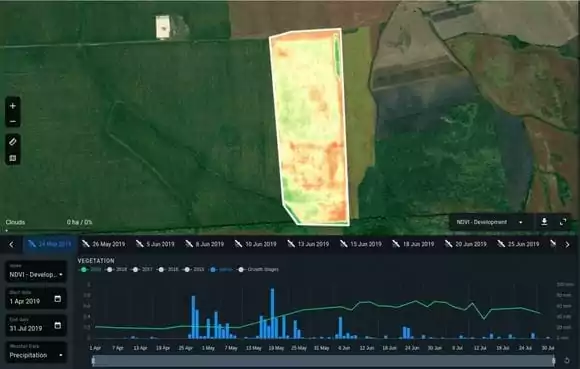
Pay attention to the chart below the map now. Apart from the vegetation index curve, there are blue vertical bars signifying the precipitation levels for certain periods of time. It is clear from the chart, the field has received extreme quantities of rain in May. EOSDA Crop Monitoring users can check other weather data by switching between precipitation, temperature, cold stress or heat stress, to increase the awareness about the field’s state at any given moment.
For example, continuing examining the flooding of that field, an insurance company has found out the average precipitation rate for May in this area for the previous five years. The chart compares the average rate (shown in orange) with the actual rainfall amount (in blue) prior to the claim. You are seeing, therefore, what they saw: a farmer had expected a maximum of 20mm but got almost 100mm instead. This chart proves that the field received up to 5 times more precipitation than had been expected. In other words, it wasn’t the farmer’s fault (he did not overwater the field) but a force majeure event.
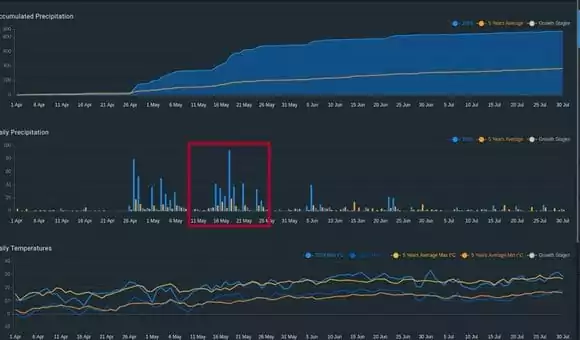
Weather can unexpectedly freak out, especially within the larger context of global climate change today. EOSDA Crop Monitoring helps to keep the weather in constant check by knowing the 5-year average figures and values which can be predicted as well (forecast feature).
Farming Apps Boosting Crop Scouting
Farming apps integrate big data retrieved from various sources to make field monitoring and crop scouting easier, more accurate, and cost-efficient. Conventional crop scouting, with its toils, blind walking patterns, and stacking paperwork, could be upgraded with the help of scouting apps. Remote sensing reveals productivity zone variations across the field. Anyone with an app such as EOSDA Crop Monitoring is able to instantly create a scouting task and monitor its performance in real-time. The scout will use the mobile app on any handheld device, relying on GPS and internet connection, to collect and share valuable information on the state of the crops with accuracy and without delay.
About the author:
Rim Elijah holds a double degree in business administration and political science from Stockholm University. As a VP of Sales at EOSDA, she oversees all aspects of business model development and implementation and the growth of the company’s global coverage. She has successfully established a number of strategic partnerships with an emphasis on sustainable solutions in Africa and Asia.
Recent articles

Analyze 2025 & Plan Your Best Year Yet: LandViewer Christmas Offer
It’s the most wonderful time of the year! The Christmas holidays are here, and so is your chance to analyze 2025 and plan a prosperous 2026 with more affordable Pro plans in LandViewer.

EOSDA Models Climate Change Impact On Sugarcane Yields
EOSDA modeled future temperature, rainfall, and other climate impacts on Veracruz sugarcane. The results help growers plan long-term adaptation strategies, including timing, varieties, and irrigation.

EOSDA LandViewer Black Friday Sale: Exclusive Offers & Giveaway
This Black Friday, LandViewer offers new users the chance to save on monthly plans, get extra months with yearly subscriptions, and participate in a free annual plan giveaway.